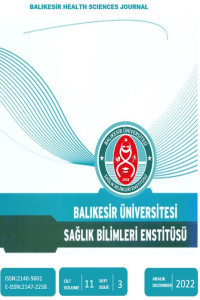KLAS III VE KLAS IV DEFORMASYONLARIN NANOKOMPOZİT BİR RESTORATİF MATERYAL İLE ESTETİK REHABİLİTASYONU: BİR OLGU SUNUMU
GİRİŞ: Bu olgu sunumunda iki farklı kavite dizaynına sahip kavitelerin modern teknik ve materyaller ile estetik rehabilitasyonu ele alınmış ve işlem aşamaları şekiller eşliğinde aktarılmıştır. YÖNTEM: Gönüllü olarak çalışmaya katılmayı kabul eden iki farklı hastada yer alan Klas III ve Klas IV kaviteler elmas frezler yardımıyla restorasyona hazır hale getirilmiştir. Aynı tip adeziv ve bir nanokompozit restoratif materyali ile farklı matriks sistemleri kullanılarak dişlerin restorasyonları gerçekleştirilmiştir. Uygulanan materyaller üretici firmaların talimatları doğrultusunda kullanılırken, restorasyonların yapımı aşama aşama ve şekiller üzerinden anlatılmıştır. Her iki restorasyonun bitim aşamasında da aynı tip cila sistemi kullanılarak restorasyonlara son hali verilmiştir. TARTIŞMA VE SONUÇ: Adeziv diş hekimliğinde yaşanan gelişmelere paralele olarak estetik restorasyonlara ilgi artmış ve kompozit materyallerin kullanımı diş hekimliği alanında oldukça yaygınlaşmıştır. Nanoteknolojinin gelişimi direkt kompozit restoratif materyallerden biri olan nano kompozitlerin üretimini sağlamış ve böylelikle özellikle anterior bölgede minimum doku uzaklaştırarak, maksimum fonksiyon, tutuculuk, dayanıklılık ve estetik elde edilebilecek restorasyonların yapımına olanak sağlanmıştır.
Anahtar Kelimeler:
Estetik Kompozit, Klas III, Klas IV, Nanokompozit
___
- 1. Brunthaler A, König F, Lucas T, Sperr W, Schedle A. Longevity of direct resin composite restorations in posterior teeth. Clin Oral Investig 2003;7(2):63-70.
- 2.Chen MH. Update on dental nanocomposites. J Dent Res 2010;89(6):549-560.
- 3.Devoto W, Pansecchi D. Composite restorations in the anterior region: clinical and aesthetic performances. Pract Proced Aesthet Dent 2007;19(8):465-470.
- 4.Robinson S, Nixon PJ, Gahan MJ, Chan MF. Techniques for restoring worn anterior teeth with direct composite resin. Dent Update 2008;35(8):551-552, 555-558.
- 5.Castelnuovo J, Tjan AH, Phillips K, Nicholls JI, Kois JC. Fracture load and mode of failure of ceramic veneers with different preparations. J Prosthet Dent 2000;83(2):171-80.
- 6.Jang CM, Seol HJ, Kim HI, Kwon YH. Effect of different blue light-curing systems on the polymerization of nanocomposite resins. Photomed Laser Surg. 2009;27(6):871-876.
- 7.Terry DA. Direct applications of a nanocomposite resin system: Part 1-The evolution of contemporary composite materials. Pract Proced Aesthet Dent. 2004;16(6):417-422
- 8.Backman B, Holm AK: Amelogenesis imperfecta: prevalence and incidence in a northern Swedish county. Community Dent Oral Epidemiol 1986;14(1):43-7.
- 9.Lee YK, Lim BS, Kim CW. Effect of surface conditions on the color of dental resin composites. J Biomed Mater Res 2002;63(5):657- 63.
- 10.Davis N. A nanotechnology composite. Compend Contin Educ Dent. 2003;24(9):665-667.
- 11.Mitra SB, Wu D, Holmes BN. An application of nanotechnology in advanced dental materials. J Am Dent Assoc. 2003;134(10):1382-1390.
- 12.Chiche GJ, Pinault A: Esthetics of anterior fixed prosthodontics, s.42-46, Quintessence Int., Chicago (1994).
- 13.Kıvanç BH, Arısu HD. Direkt kompozit rezin venerlerle diastema kapatılması: Olgu raporu. Ado Klinik Bilimler Dergisi 2009;3(1):285-8
- 14.Hemmings WK, Darbar UR, Vaughan S. Tooth wear treated with direct composite restorations at an increased vertical dimension: Results at 30 months. J Prosthet Dent 2000;83(3): 287-93.
- 15.Wilson NHF, Mjör IA. The teaching of Class I and Class II direct composite restorations in European dental schools. J Dent 2000;28(1):15-21.
- 16.Magne P, Belser UC. Porcelain versus composite inlays/ onlays: effects of mechanical loads on stress distribution, adhesion, and crown flexure. Int J Periodontics Restorative Dent 2003 Dec; 23(6):543–55.
- 17.Berksun S, Kedici PS, Saglam S. Repair of fractured porcelain restorations with composite bonded porcelain laminate contours. J Prosthet Dent 1993 May;69(5)457-8
- 18.Willhite C. Diastema closure with freehand composite: controllingemergence contour. Quintessence Int 2005;36(2):138-40.
- ISSN: 2146-9601
- Yayın Aralığı: Yılda 3 Sayı
- Başlangıç: 2012
- Yayıncı: Balıkesir Üniversitesi
Sayıdaki Diğer Makaleler
Fatma TOK YILDIZ, Mağfiret KAŞIKÇI
SORAFENİB ETKİN MADDESİNİN SPEKTROFOTOMETRİ YÖNTEMİYLE FARMASÖTİK PREPARATLARDA ANALİZİ
Oğuz EMRE, Ayşe Gül UYAR, Zekeriya ÇALIŞKAN, Ayşegül ULUTAŞ
HEMŞİRELİK BÖLÜMÜ ÖĞRENCİLERİNİN SAĞLIKLI YAŞAM BİÇİMİ DAVRANIŞLARININ İNCELENMESİ
Öznur Yaşar, Nuriye KARADAĞ, Gözde ÖZSEZER KAYMAK
ÇOCUKLARDA AMELİYAT ÖNCESİ PSİKOLOJİK HAZIRLIK: GÜNCEL YAKLAŞIMLAR
HEMŞİRELERİN PROFESYONELLİK DÜZEYLERİNİN DEĞERLENDİRİLMESİ: BALIKESİR ÖRNEĞİ
Ayşe KARADAŞ, Serap Kaynak, Songül DURAN, Sibel ERGÜN
ANNELERİN ÇOCUKLARININ ATEŞİNE MÜDAHALE YAKLAŞIMLARININ İNCELENMESİ
